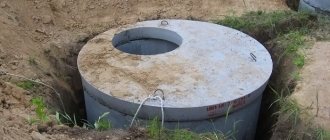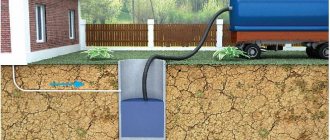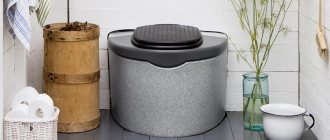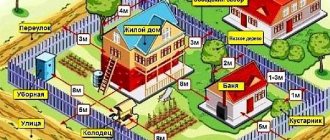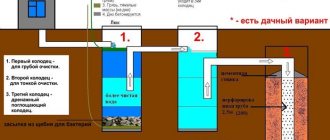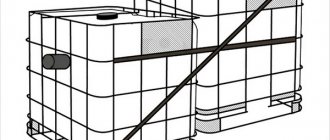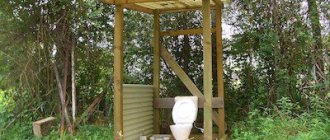For many city dwellers, a country house becomes a dream come true. However, in order for it to be as comfortable as apartments in multi-storey buildings, the owners have to work hard. If there is usually not the slightest problem with the arrangement of a water supply system, then the organization of an autonomous system for collecting wastewater often raises many questions. To create a local sewer system, many owners choose a sealed, safe, practical container - a septic tank. This treatment plant not only collects wastewater, but also filters it. But for the system to work effectively, its correct installation is important. Therefore, owners need to find out in advance what requirements apply to the construction, and how to properly install a septic tank in a private house.
What is a septic tank?
These designs appeared not so long ago. Previously, they were replaced by cesspools, in which a container was either installed or left as is. Such solutions have long been unpopular; their main disadvantages are constant soil contamination, unpleasant odors in the area, and a small volume of liquid waste that can be recycled.
A septic tank is a sealed structure consisting of several chambers connected by pipes. Its purpose is the collection and subsequent treatment of domestic wastewater. The waste liquid in this system settles, is gradually purified, and flows from one compartment to another. The greater the number of compartments, the cleaner the water becomes. Purification systems come in different types, sizes, and filtration methods may also vary slightly. The choice of structure depends on the soil on the site, on the available space, and on the desire of the owners to spend this or that amount on arranging effective cleaning.
The septic tank has several functional compartments. First, waste water enters the first chamber through sewer pipes. This is where primary settling occurs. The largest particles settle to the bottom, and fat, on the contrary, floats to the surface. Then this settled liquid flows into the second compartment. Smaller particles are filtered out in the same way. Water with a higher level of purification finally flows into a filtration well, where it is finally cleared of all impurities and then goes into the ground. Not all buildings have a third camera. It all depends on the type of construction.
Type of structures
Before moving on to the question of how to properly install a septic tank in a private house, you need to get acquainted with the types of structures, since there are quite a lot of options - from the simplest to the most complex, equipped with biofilters. Septic tanks are sold completely ready for installation, and their installation is usually carried out by specialists. But there are exceptions to any rule: if you get acquainted with the requirements and the order of work, then you can carry out all the stages yourself.
There are now three main types of septic tanks, they differ in the principle of operation of the system.
Cumulative
This is the simplest option, which is the basis for other types of cleaning systems. In this case, a container is used that receives liquid waste. By and large, this is the same cesspool; a sewer truck is required to empty it. This design is only suitable for houses where people do not live permanently.
If the house has a bath, shower, washing machine, then this option should not be considered. However, storage capacity may be a suitable solution if:
- there is no place on the site for a full-fledged septic tank with several compartments;
- the groundwater level is as close as possible to the surface;
- There is a source of drinking water nearby.
In these cases, installing a simple storage tank may be justified.
Septic tanks with soil treatment
These structures are no longer simple cesspools, but not yet full-fledged treatment facilities. These are overflow structures; they consist of several sealed chambers. In them, water undergoes several stages of purification to remove large and small inclusions, and then is discharged into the ground.
The cleaning process has already been described above, but instead of a filtration well, such a system may have filtration drainage fields. These are areas covered with sand and gravel, on which perforated pipes are laid. The tanks of such septic tanks require regular cleaning: at least once every 3 years, but it is better to reduce this period to 2 years.
Biological treatment systems
This is the most modern, almost perfect, environmentally friendly equipment. Water after such filtration makes it possible to use it for irrigation. The recycled liquid also does not cause the slightest harm to the environment. In such septic tanks, all the main work is done by bacteria, which decompose all unsafe substances.
Fermentation of liquid waste has 2 stages - acidic and methane. During the first stage, proteins, carbohydrates, and fats are broken down into lower acids, hydrogen sulfide, alcohols and carbon dioxide. In the second stage, substances decompose to hydrogen and methane. To remove gases into the atmosphere, bioseptic tanks must be equipped with a ventilation system.
How to calculate the volume of a sewer system?
Manufacturers of wastewater treatment systems for private houses, such as Tver and Topas, recommend planning the volume of future sewage on the basis that for each person living in the house there is 200 liters of wastewater per day. Experts say you shouldn’t skimp on volume.
For a concrete septic tank for a family of 5 people, you will need either three standard reinforced concrete rings (each 90 cm high and 150 cm in diameter), or, if you are building a treatment facility using the pour-in method, a pit with a volume of 8 m3 and the appropriate amount of concrete.
The more additional sections there are in your sewer system, the less load will fall on each of them and, therefore, the longer they will last. Remember: the septic tank must be cleaned regularly, but not all parts of it can be cleaned. When laying an autonomous sewer system with your own hands, it is better to think through its design so that it serves you as long as possible.
Materials for septic tanks
To make such a cleaning system yourself, you can use concrete rings, brick, or metal. If we talk about the material of purchased models, then in this case two options are most often considered - plastic or fiberglass. However, there are also metal structures.
Concrete rings
These massive pieces are reliable and stable, which is why they often become wells and septic tanks. However, before choosing these designs, you need to know about the disadvantages. This:
- the need to ensure the tightness of the joints, but no one can guarantee that they will not leak in the near future;
- vulnerability: due to metal reinforcement, corrosion is possible, so the maximum service life of a septic tank is difficult to predict.
Another disadvantage is the weight of concrete rings. It requires the presence of lifting equipment, and its involvement will result in additional costs.
Brick, stone
This material allows you to obtain a durable, reliable and inexpensive sump. Brickwork is constructed in the pit, then it is waterproofed using bitumen and/or cement. The downside of the material is that it takes a lot of time. Such a septic tank can also fail, since its complete tightness cannot be guaranteed.
Metal
These ready-made structures have a reasonable price, however, like concrete rings, metal septic tanks are characterized by significant weight. Due to their high thermal conductivity, metal containers require insulation. Another disadvantage is the risk of distortion and extrusion. To avoid consequences, septic tanks are installed on concrete slabs.
Plastic, fiberglass
Eurocube is the first candidate for self-manufacturing a septic tank, however, such a lightweight container requires high-quality reinforcement of the bottom and walls of the pit. Purchased designs have the same disadvantages. Fiberglass products are the best option; they are not afraid of deformation or temperature changes. But they also need an “anchor”.
Choosing a septic tank and location on the site
Even a completely sealed structure must meet safety requirements, since no one is insured against an accidental accident. Septic tanks must be located at a distance:
- 50 meters from sources of drinking water, on sandy soils the distance is greater - 80 m;
- 30 meters from bodies of standing water (lake, reservoir, pond);
- 10 meters from bodies of water with running water (rivers or streams);
- 3-5 meters from roads (5 m), buildings (4 m), site boundaries (3 m).
The structure must be at least 3 meters away from trees and bushes. This is the first answer to the question of how to properly install a septic tank in a private home.
To select the optimal system for treating household wastewater, several factors must be taken into account.
- The size of the septic tank chambers. In this case, the number of residents, plumbing fixtures, and the number of large containers (baths, pools) are taken into account.
- Possibility to do several levels of cleaning. A larger number of system tanks guarantees the safety of the site.
- Free space that can be “painlessly” allocated for settling tanks.
- Type of septic tank, its effectiveness.
If we focus on the standards, then one person produces about 200 liters of wastewater (0.2 m3) per day. This indicator is average: for example, if a tenant takes a bath (not a shower) every day, then it is better to double the norm. It's minimum.
For example, for a typical mini-family (parents and one child), the volume of the septic tank can be in the range of 1.8-3.6 m3. In this case, some reserve will not hurt, so it is better to round the numbers to 2-4 cubic meters. The capacity of all cleaning chambers does not matter. Only one is important, the first receiver compartment.
Septic tanks can be horizontal or vertical. The first ones are chosen for those areas where the groundwater level is high. The possibility of using the latter is completely excluded if they are located very close to the surface of the earth.
About the filter cassette
The distribution well is equipped with an automated pump (submersible is used). Pumping them and directs the wastewater into the filter cassette. To install such a system, a fertile layer of soil is removed, the perimeter of which is 50 cm larger than the analogue.
Next, a mini pit 30-50 cm deep is filled with sand and thoroughly compacted. Concrete blocks are placed along the perimeter of the site and fastened together. Then fine gravel is poured in and an infiltrator without a bottom is installed, i.e. cassette. A hose or pipe is connected to it for drainage, and a pipe for ventilation is also formed. The cassette is insulated with foam plastic and covered with a 20-centimeter layer of soil.
1 - wastewater supply pipeline; 2 - filter base; 3 - supporting blocks made of concrete or reinforced concrete; 4 - reinforced concrete floor slab; 5 - filtration wells; 6 — ventilation riser; 7 - wooden cover; 8 - drainage tray; 9 — hatch; 10 - waterproofing; 11 - stone blind area; 12 - stone paving; 13 — cast iron hatch; 14 — jet barrier wall
To increase the filtration area, additional wells are provided.
The optimal size of the loading fragment for the base filter is crushed stone with a fine fraction (screening), slag, expanded clay, etc. with a fraction size of 2-10 mm. For paving, we recommend a stone of 60-100 mm.
The jet wall requires a gap of 15-20 mm between the blocks.
How to properly install a septic tank in a private house?
Before starting any work, it is necessary to determine which septic tank will be the optimal design for specific conditions. It is ideal to start preparing after purchasing the structure. First, markings are made on the site, then a pit and trenches are dug for laying pipes. They should have a slope of 2° per meter, this is the minimum. Then they proceed to the installation of elements of the treatment system. The last stage is checking and adjusting the operation of the equipment.
Pit preparation
Its size is selected taking into account the dimensions of the purchased septic tank. The pit should be 400-500 mm wider and 500-1000 mm deeper. The bottom of the pit must be leveled, then a layer of gravel (minimum 100 mm) and sand of the same thickness is poured. The resulting pillow is carefully compacted and the horizontal level is checked. If necessary, level it.
Since the weight of finished septic tanks is often too small, to minimize the risk of the structure “floating”, a concrete base is poured or a reinforced concrete slab is laid. With moving soils, more work is required. In this case:
- they are digging a pit, but of a much larger size;
- a wooden sheathing with a reinforcing belt is installed along its perimeter;
- a hole (or holes) for sewer pipes must be left in it;
- then the solution is poured: both into the sheathing and to the bottom of the pit.
Such preliminary preparation is almost always necessary for plastic containers, which are easily deformed during seasonal movements.
Installation of a sump
The procedure and features of installation depend on which design is chosen - purchased or homemade.
Ready septic tank
If you purchased a factory-made septic tank, then the work does not foretell any particular difficulties, since installing a septic tank correctly in a private house is quite simple. It is carefully lowered into the prepared pit. When necessary, the container is attached to the anchor plate. This is done in two ways: either they attach the tank with steel brackets that have anti-corrosion protection, or they use synthetic (nylon, polyester) tightening belts. The latter option is preferable, since such fastening will not be affected by an aggressive environment.
- After fixing the structure, the pit is only half filled with sand. Then the tank is filled with water, and the sand is also spilled. This stage will help prevent deformation of the container walls during operation.
- The septic tank is lined with heat-insulating material: for example, thick polystyrene foam (expanded polystyrene). The upper part of the structure is covered with a double layer, since it will be located almost on the surface of the earth.
- The next stage is installation of the pipeline. In this case, no particular difficulties arise, since the main thing is to ensure the required slope towards the septic tank. Pipe insulation is carried out if it is necessary due to the harsh climate.
If the system provides forced ventilation, then install a ventilation pipe and run a cable. Electrical wires must be protected with a corrugated pipe. The last stage is filling the structure with sand.
Sump made of concrete rings
In this case, waterproofing is laid on the gravel-sand cushion, preferably several layers. Then the ring is lowered, the reinforcement is installed and filled with mortar. A special mixture is applied to its upper edge. It consists of cement (1 part), fine sand (2) and liquid glass (0.1).
Since such a solution sets very quickly, it is prepared in small portions if the septic tank consists of a large number of rings. In case of moving soil, the rings are additionally connected with brackets. A solution is also placed on top of the second element, on which a lid is “placed”, which has a hole for ventilation and a metal hatch cover.
A concrete sump requires high-quality waterproofing. The joints from the outside are coated with a solution, then the entire surface is coated twice with hot bitumen. The last layer of external protection is roll waterproofing. On the inside, the joints of the rings are also coated with cement mortar.
Drainage system or filter well
The first type is often used for factory septic tanks, the second is a logical solution for a septic tank made of concrete rings.
Drainage field
Filtration drainage fields are considered the best alternative to a well, because they are more economical to construct, but are in no way inferior in quality of cleaning. Perforated corrugated pipes are used for filtration.
The trenches for this section are dug in such a way that their bottom is below the liquid level in the installed septic tank. This is necessary for water drainage. Geotextiles and pipes are placed at the bottom of the drainage trench. They are covered with expanded clay (gravel) on top and wrapped in fabric. The resulting cocoon is covered with earth. Such drainage must have a ventilation duct.
Filter well
The depth of this structure is about 3 meters. Geotextiles are also laid at the bottom of the pit, always with a large overlap on the walls: the height of the reserve should be equal to the height of the first ring. Then a base is made of large crushed stone and broken bricks. After this, a concrete filter ring with perforation is installed in the pit.
A solution with liquid glass is also placed on its upper part, then blind rings are installed. All joints are similarly coated with the solution. Filter materials are poured onto the bottom of the well: gravel, small stones, expanded clay residues or brick fragments. A plate is installed on top, in which there is a hatch and a ventilation hole.
Installation of a sump
The bottom of the pit is covered with 10-15 cm of sand and filled with water to maximize shrinkage. Next, the joint between the ring and the bottom is waterproofed in order to minimize contamination of the soil with water from drains.
The second ring is installed on the solution (1 part cement + 3 sifted sand + 0.1 liquid glass).
Is there a possibility of ground movement? To further secure the rings, use staples or metal plates.
The hatch with a cover is placed on a bed of standard sand-cement mortar.
1 — rings of the working part; 2 — insulating cover; 3 — neck rings; 4 — hatch body; 5 — hatch cover; 6 — ventilation riser; 7 - floor slab; 8 — bottom plate; 9 — crushed stone cushion; 10 - waterproofing; 11—sediment zone; 12 — running brackets
It is advisable to waterproof a sump tank, unlike a well that filters wastewater, with 2 layers of hot bitumen. Waterproofing is carried out over the primer with a solution of bitumen and gasoline. Coating with water-repellent penetrating compounds is possible. Additionally, the sump tank is insulated from the outside with bitumen roll insulation.
Conditions for good work
To get an effectively working septic tank, you need to pay attention to several necessary conditions.
Overflows, ventilation
Overflows should be located below the sewer pipe through which the waste flows directly into the receiver. The minimum difference is 100 mm. To ensure that the liquid is immediately directed to the lower part of the container, tees are installed at the ends of the overflows.
To ensure the flow of fresh air into the septic tank, high-quality ventilation is necessary. If there are several cameras, then it is mounted either in the first or in the last container. The minimum diameter of ventilation risers is 100 mm. The inflow must be positioned so that it is always above the surface of the wastewater. Gases are vented from the receiver through a sewer riser leading to the roof of the house. It is equipped with deflector caps.
Installation of a filter well
The parameters of the area used are calculated by the load on S of the bottom filter, which is located inside the well and S of holes in the walls, multiplied by the height of the structure. In sand, the latter are characterized by 100 l/day per 1 m2, and in sandy loam soil 50 l/day.
The limit for the filter base is calculated above the level of existing soil in the strata. water If there is 2 m between the base of the filter well and the level of the latter, then an increase in load by 20% is allowed.
1 — water barrier; 2 — neck rings; 3 — hatch cover; 4 — insulating cover; 5 — hatch body; 6 - floor slab; 7 - ventilation riser; 8 — blind rings; 9 — perforated rings; 10 - filter media; 11 — holes in the rings; 12 — concrete base; 13 - supply pipeline
It is rational to equip the walls of the filter well with rhythmically spaced holes Ø40-60 mm. The total area of the latter should be ≈10% of all walls. This technique can slightly increase the absorbent surface area.
As a bottom, use a filter up to 300 mm thick from any broken stone with fractions of 15-30 mm.
We recommend reading the instructions for building a drainage well.
